In 1915, the British and the Germans fought each other at the Battle of Loos in France. The battle is known for being the first time that the British used poison gas during World War I.
But is also renowned for being a battle in which the British decided to display their bravado and courage whilst moving towards the German front line in a bizarre way.
A group of British soldiers came up with the idea of dribbling six footballs towards the German front line when they are sent over the top and use the Germans' trenches as the goal.
But, on the eve of the battle, their commander discovered the crazy plot and shot five of the balls to render them useless.
But the football team of the London Irish Rifles managed to hide one of the balls and, defying orders, they dribbled it as they advanced across No Man's Land while under heavy machine gun and mortar fire!
As the whistle for the 'big push' sounded, London Irish football team captain Sgt Frank Edwards booted the ball out of the trenches, to cries of "On the ball London Irish!"
He dribbled it for 20 yards towards the enemy before being shot in the thigh. The ball passed between a small band of men before it ended up being pierced on barbed wire on the German front line (how inconvenient for there to be barbed wire strewn across the pitch whilst British troops were trying to play football. Not only could it have burst the ball - which it did do - but some poor soldier could have hurt himself if he stood on it).
The antics of the London Irish Rifles that day went down in regimental folklore and the ball was displayed at the regimental museum in Camberwell, south east London, until 50 years ago.
After that it languished in a container in the sergeant's mess at the museum for the next five decades but recently resurfaced in a decrepit state and in danger of perishing into a pile of dust.
Conservation experts were called in to restore the ball and it will now be the centrepiece of the regiment's St Patrick's Day parade this weekend.
The Battle of Loos saw 50,000 British and 25,000 German deaths, but it was a British victory.
Nigel Wilkinson, vice-chairman of the London Irish Rifles Regimental Association, explained: 'The London Irish had a first class football team and they were keen to score a goal in Jerry's front line trenches.
'One of the platoon commanders thought this was a bad idea and just before the whistles blew for the attack he went round puncturing all those that he could find.'
This wasn't the only extraordinary incident involving a football during WWI.
At Christmas 1914, 100,000 British and German soldiers faced each other across No Man's Land at Ypres in Belgium.
On Christmas Eve, German troops began decorating the area around their trenches. They placed candles on their trenches and on Christmas trees, then continued the celebration by singing Christmas carols. The British responded by singing carols of their own. The two sides continued by shouting Christmas greetings to each other.
Soon thereafter, there were excursions across No Man's Land, where the opposing troops met, shook hands and exchanged small gifts, such as food, tobacco and alcohol, and souvenirs such as buttons and hats. They also showed each other photographs of their wives and girlfriends back home.
The artillery in the region fell silent.
The truce also allowed a breathing spell where recently fallen soldiers could be brought back behind their lines by burial parties. Joint services were held.
But the most famous occurrence of the truce was the football match played between the British and Germans on No Man's Land, which the Germans won 3-2. Eventually, by mutual consent, the truce ended and the two sides continued slaughtering each other. This showed that, even though they were killing each other, there was nothing personal involved and that they were merely following orders.
Football on the frontline: The ball British WWI soldiers dribbled towards their deaths after being sent over the top
By Daily Mail Reporter
10th March 2011
Daily Mail
But, while staring death in the face, a group of World War One soldiers hatched a plan to dribble six footballs towards the German front line in a unique display of British bravado and courage.
Their commanding officer rumbled them on the eve of the Battle of Loos in 1915, and before the attack shot five of the balls rendering them useless.
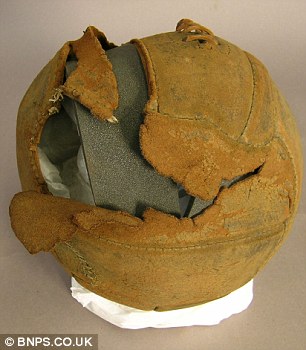
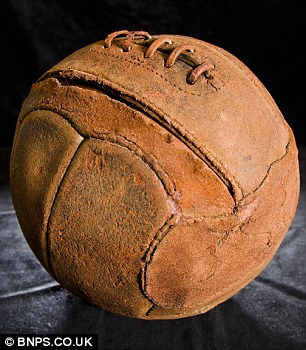
The football was in danger of disintegrating after languishing in the sergeant's mess for 50 years, but experts painstakingly restored it for this weekend's regimental St Patrick's Day Parade
But the soccer team of the London Irish Rifles managed to keep the sixth ball hidden and, defying orders, dribbled it as they advanced across No Man's Land while under heavy machine gun and mortar fire.
The footballing soldiers' antics, even more extraordinary than the official truce called on Christmas Day 1914 when thousands of British and German troops emerged from the trenches to have a kick-about, went down in folklore among the men of the London Irish Rifles and the ball was displayed at the regimental museum in Camberwell, south east London, until 50 years ago.
After that it languished in a container in the sergeant's mess at the museum for the next five decades but recently resurfaced in a decrepit state and in danger of perishing into a pile of dust.
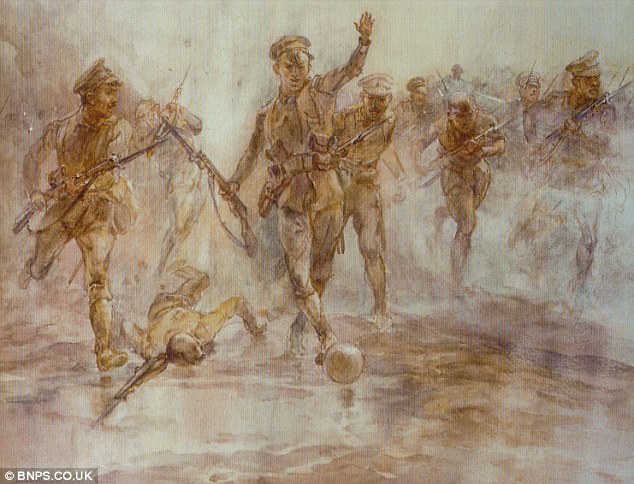
Surely the craziest battlefield stunt British soldiers took part in since the Light Brigade suicidally charged towards thousands of heavily-armed Russians at Balaclava in 1854: The painting by Lady Butler that immortalised footballers of the London Irish Rifles charging the German lines at the Battle of Loos in 1915 whilst dribbling a football
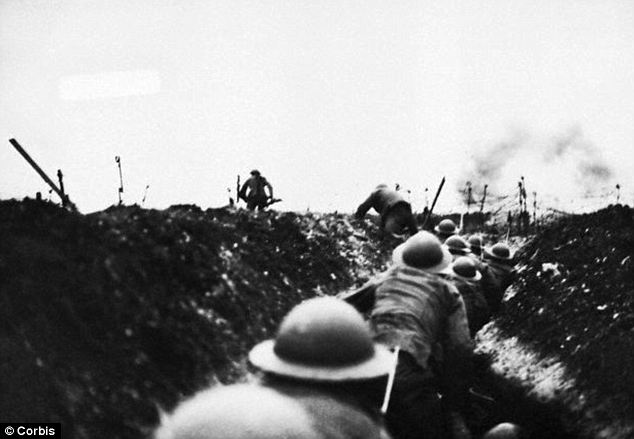
A British officer leads the way amidst bursting German shells during an offensive in April, 1918. Soldiers from the London Irish Rifles hatched a plan to dribble six footballs towards the German front line in a unique display of British bravado and courage
Conservation experts were called in and, after painstaking restoration, the ball will now be the centrepiece of the regiment's St Patrick's Day parade this weekend.
The 1st Battalion of the London Irish Rifles was sent to the Western Front in May 1915 and took part in the first major British offensive of the war in September.
Nigel Wilkinson, vice-chairman of the London Irish Rifles Regimental Association, explained: 'The London Irish had a first class football team and they were keen to score a goal in Jerry's front line trenches.
'One of the platoon commanders thought this was a bad idea and just before the whistles blew for the attack he went round puncturing all those that he could find.'
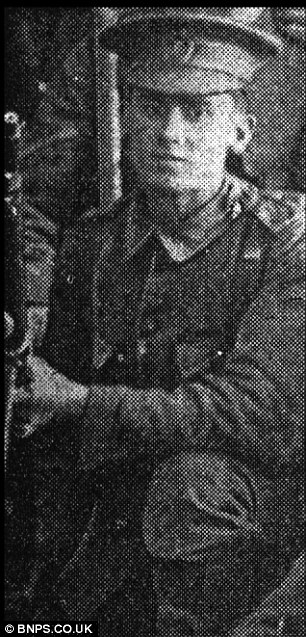
London Irish football team captain Sgt Frank Edwards who punted the ball out of the trenches and dribbled it for 20 yards towards the enemy before being shot in the thigh
But the last remaining ball had been stuffed up the tunic of team captain Sergeant Frank Edwards who removed it and blew it up with his mouth while his comrades gave him cover.
As the whistle for the 'big push' sounded, Sgt Edwards booted the ball out of the trenches. It was passed between a small band of men before it ended up being pierced on barbed wire on the German front line.
'Defying orders, the London Irish kicked off the big push by punting the football into No Man's Land and went hell for leather after it,' Mr Wilkinson said.
Sgt Edwards was said to have dribbled the ball for 20 yards before he went down injured when he was shot through the thigh. Private Micky Mileham stopped to fix a tourniquet to the wound and saved his life.
Pte Mileman, Pte Bill Taylor and Pte Walter 'Jimmy' Dalby were later recorded as having kicked the ball at some point.
Some time after the devastating battle - which resulted in 50,000 British casualties - the muddy ball was recovered from the battlefield and taken back to Britain.
'The ball wasn't necessarily lost over the last 50 years but more overlooked and neglected, Mr Wilkinson explained.
'Frank Edwards' grandson-in-law Ed Harris recently wrote a book called the Footballer of Loos. During his research he asked us what had happened to the ball after it was removed from the museum.
'We found it in a container in the sergeant's mess. It was in a very poor condition and was at risk of disintegrating into dust.
'We are delighted the ball has been conserved and will be okay for another 100 years and will be the focus of the story of the Battle of Loos.'
In the battalion's record of World War One, Second Lieutenant SF Major noted how the men were seen to pass and re-pass the ball until they disappeared in a smoke cloud towards the German front line.
In his record in the Weekly Dispatch, Pte Phil Gibbs wrote of how the men cried out 'on the ball London Irish' as they advanced.
The episode was later immortalised in a watercolour painting by historical artist Lady Butler.
Susan Harris, granddaughter of Sgt Edwards, from Whitton, south west London, who died in 1964 aged 71, said: 'I remember my grandfather very well and remember his love of football.

Come on, ref! He's way offside!: A comic cartoon depicting the men of the London Irish Rifles booting their football towards the German Front Line
'His story is one that has been forgotten about so I'm delighted that his ball has been conserved for the future.'
Yvette Fletcher, head of conservation at the Leather Conservation Centre in Northampton, said: 'It came to us in quite a bad state. There were a lot of tears in the leather which was very weak and we were concerned it would fall apart.
'We used leather dyed the same colour and we patched it together from the inside. The rubber bladder had completely perished so we padded the inside out with pure cotton to give it the shape.
'There is still the rudimentary stitching on the ball from where it was repaired having been cut on the barbed wire.
'It is still very fragile which is not surprising as it is a football that has been through the First World War.'
dailymail.co.uk
But is also renowned for being a battle in which the British decided to display their bravado and courage whilst moving towards the German front line in a bizarre way.
A group of British soldiers came up with the idea of dribbling six footballs towards the German front line when they are sent over the top and use the Germans' trenches as the goal.
But, on the eve of the battle, their commander discovered the crazy plot and shot five of the balls to render them useless.
But the football team of the London Irish Rifles managed to hide one of the balls and, defying orders, they dribbled it as they advanced across No Man's Land while under heavy machine gun and mortar fire!
As the whistle for the 'big push' sounded, London Irish football team captain Sgt Frank Edwards booted the ball out of the trenches, to cries of "On the ball London Irish!"
He dribbled it for 20 yards towards the enemy before being shot in the thigh. The ball passed between a small band of men before it ended up being pierced on barbed wire on the German front line (how inconvenient for there to be barbed wire strewn across the pitch whilst British troops were trying to play football. Not only could it have burst the ball - which it did do - but some poor soldier could have hurt himself if he stood on it).
The antics of the London Irish Rifles that day went down in regimental folklore and the ball was displayed at the regimental museum in Camberwell, south east London, until 50 years ago.
After that it languished in a container in the sergeant's mess at the museum for the next five decades but recently resurfaced in a decrepit state and in danger of perishing into a pile of dust.
Conservation experts were called in to restore the ball and it will now be the centrepiece of the regiment's St Patrick's Day parade this weekend.
The Battle of Loos saw 50,000 British and 25,000 German deaths, but it was a British victory.
Nigel Wilkinson, vice-chairman of the London Irish Rifles Regimental Association, explained: 'The London Irish had a first class football team and they were keen to score a goal in Jerry's front line trenches.
'One of the platoon commanders thought this was a bad idea and just before the whistles blew for the attack he went round puncturing all those that he could find.'
This wasn't the only extraordinary incident involving a football during WWI.
At Christmas 1914, 100,000 British and German soldiers faced each other across No Man's Land at Ypres in Belgium.
On Christmas Eve, German troops began decorating the area around their trenches. They placed candles on their trenches and on Christmas trees, then continued the celebration by singing Christmas carols. The British responded by singing carols of their own. The two sides continued by shouting Christmas greetings to each other.
Soon thereafter, there were excursions across No Man's Land, where the opposing troops met, shook hands and exchanged small gifts, such as food, tobacco and alcohol, and souvenirs such as buttons and hats. They also showed each other photographs of their wives and girlfriends back home.
The artillery in the region fell silent.
The truce also allowed a breathing spell where recently fallen soldiers could be brought back behind their lines by burial parties. Joint services were held.
But the most famous occurrence of the truce was the football match played between the British and Germans on No Man's Land, which the Germans won 3-2. Eventually, by mutual consent, the truce ended and the two sides continued slaughtering each other. This showed that, even though they were killing each other, there was nothing personal involved and that they were merely following orders.
Football on the frontline: The ball British WWI soldiers dribbled towards their deaths after being sent over the top
By Daily Mail Reporter
10th March 2011
Daily Mail
- Ball used in amazing stunt stitched up again after discovery nearly 100 years after Battle of Loos
But, while staring death in the face, a group of World War One soldiers hatched a plan to dribble six footballs towards the German front line in a unique display of British bravado and courage.
Their commanding officer rumbled them on the eve of the Battle of Loos in 1915, and before the attack shot five of the balls rendering them useless.


The football was in danger of disintegrating after languishing in the sergeant's mess for 50 years, but experts painstakingly restored it for this weekend's regimental St Patrick's Day Parade
But the soccer team of the London Irish Rifles managed to keep the sixth ball hidden and, defying orders, dribbled it as they advanced across No Man's Land while under heavy machine gun and mortar fire.
The footballing soldiers' antics, even more extraordinary than the official truce called on Christmas Day 1914 when thousands of British and German troops emerged from the trenches to have a kick-about, went down in folklore among the men of the London Irish Rifles and the ball was displayed at the regimental museum in Camberwell, south east London, until 50 years ago.
After that it languished in a container in the sergeant's mess at the museum for the next five decades but recently resurfaced in a decrepit state and in danger of perishing into a pile of dust.

Surely the craziest battlefield stunt British soldiers took part in since the Light Brigade suicidally charged towards thousands of heavily-armed Russians at Balaclava in 1854: The painting by Lady Butler that immortalised footballers of the London Irish Rifles charging the German lines at the Battle of Loos in 1915 whilst dribbling a football

A British officer leads the way amidst bursting German shells during an offensive in April, 1918. Soldiers from the London Irish Rifles hatched a plan to dribble six footballs towards the German front line in a unique display of British bravado and courage
Conservation experts were called in and, after painstaking restoration, the ball will now be the centrepiece of the regiment's St Patrick's Day parade this weekend.
The 1st Battalion of the London Irish Rifles was sent to the Western Front in May 1915 and took part in the first major British offensive of the war in September.
Nigel Wilkinson, vice-chairman of the London Irish Rifles Regimental Association, explained: 'The London Irish had a first class football team and they were keen to score a goal in Jerry's front line trenches.
'One of the platoon commanders thought this was a bad idea and just before the whistles blew for the attack he went round puncturing all those that he could find.'

London Irish football team captain Sgt Frank Edwards who punted the ball out of the trenches and dribbled it for 20 yards towards the enemy before being shot in the thigh
But the last remaining ball had been stuffed up the tunic of team captain Sergeant Frank Edwards who removed it and blew it up with his mouth while his comrades gave him cover.
As the whistle for the 'big push' sounded, Sgt Edwards booted the ball out of the trenches. It was passed between a small band of men before it ended up being pierced on barbed wire on the German front line.
'Defying orders, the London Irish kicked off the big push by punting the football into No Man's Land and went hell for leather after it,' Mr Wilkinson said.
Sgt Edwards was said to have dribbled the ball for 20 yards before he went down injured when he was shot through the thigh. Private Micky Mileham stopped to fix a tourniquet to the wound and saved his life.
Pte Mileman, Pte Bill Taylor and Pte Walter 'Jimmy' Dalby were later recorded as having kicked the ball at some point.
Some time after the devastating battle - which resulted in 50,000 British casualties - the muddy ball was recovered from the battlefield and taken back to Britain.
'The ball wasn't necessarily lost over the last 50 years but more overlooked and neglected, Mr Wilkinson explained.
'Frank Edwards' grandson-in-law Ed Harris recently wrote a book called the Footballer of Loos. During his research he asked us what had happened to the ball after it was removed from the museum.
'We found it in a container in the sergeant's mess. It was in a very poor condition and was at risk of disintegrating into dust.
'We are delighted the ball has been conserved and will be okay for another 100 years and will be the focus of the story of the Battle of Loos.'
In the battalion's record of World War One, Second Lieutenant SF Major noted how the men were seen to pass and re-pass the ball until they disappeared in a smoke cloud towards the German front line.
In his record in the Weekly Dispatch, Pte Phil Gibbs wrote of how the men cried out 'on the ball London Irish' as they advanced.
The episode was later immortalised in a watercolour painting by historical artist Lady Butler.
Susan Harris, granddaughter of Sgt Edwards, from Whitton, south west London, who died in 1964 aged 71, said: 'I remember my grandfather very well and remember his love of football.

Come on, ref! He's way offside!: A comic cartoon depicting the men of the London Irish Rifles booting their football towards the German Front Line
'His story is one that has been forgotten about so I'm delighted that his ball has been conserved for the future.'
Yvette Fletcher, head of conservation at the Leather Conservation Centre in Northampton, said: 'It came to us in quite a bad state. There were a lot of tears in the leather which was very weak and we were concerned it would fall apart.
'We used leather dyed the same colour and we patched it together from the inside. The rubber bladder had completely perished so we padded the inside out with pure cotton to give it the shape.
'There is still the rudimentary stitching on the ball from where it was repaired having been cut on the barbed wire.
'It is still very fragile which is not surprising as it is a football that has been through the First World War.'
dailymail.co.uk
Last edited: